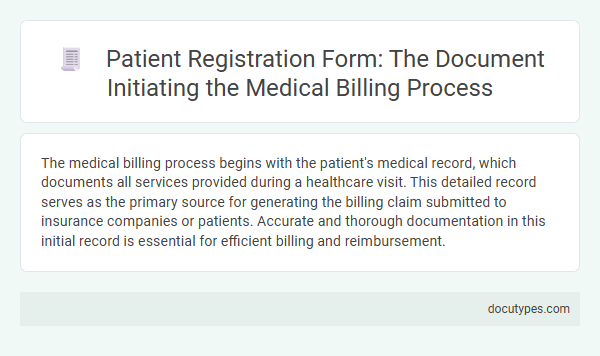The medical billing process begins with the patient's medical record, which documents all services provided during a healthcare visit. This detailed record serves as the primary source for generating the billing claim submitted to insurance companies or patients. Accurate and thorough documentation in this initial record is essential for efficient billing and reimbursement.
Introduction to Patient Registration Forms
The medical billing process begins with the patient registration form, a crucial document that collects essential patient information. This form gathers personal, insurance, and medical details necessary for accurate billing and claims processing.
Patient registration forms ensure the healthcare provider obtains accurate data to verify insurance coverage and patient eligibility. Proper completion of this form initiates efficient medical billing, reducing errors and claim denials.
Importance of Patient Registration in Medical Billing
The document that initiates the medical billing process is the patient registration form. This form collects essential personal and insurance information needed for accurate billing.
Patient registration is crucial in medical billing because it verifies insurance coverage and ensures correct patient identification. Accurate registration helps prevent billing errors and claim denials. Your cooperation during this process speeds up claim submission and reimbursement.
Key Components of a Patient Registration Form
| Which Document Initiates the Medical Billing Process? | |
|---|---|
| The medical billing process begins with the Patient Registration Form. This document captures essential patient information required to generate accurate medical bills and claims. | |
| Key Components of a Patient Registration Form | Description |
| Patient Demographics | Includes the full name, date of birth, gender, and contact information. Accurate demographics ensure the correct patient record is used for billing and insurance claims. |
| Insurance Information | Details about the patient's insurance provider, policy number, group number, and coverage limits. This information is crucial for claim submission and reimbursement. |
| Emergency Contact Details | Contact information for a person to reach in case of emergency, often required for patient safety and administrative communication. |
| Consent and Authorization | Your signature or consent confirming agreement to treatment, data sharing, and billing processes. This authorization allows healthcare providers to submit claims to insurers. |
| Medical History Summary | Basic health information, allergies, and current medications to assist in accurate diagnosis and billing of medical services. |
Information Collected on Patient Registration Forms
The medical billing process begins with the patient registration form, which gathers essential information needed for accurate billing. This initial document captures details that directly impact insurance claims and payment procedures.
- Patient Demographics - Your full name, date of birth, address, and contact information are recorded to identify the patient accurately.
- Insurance Information - Details about insurance providers, policy numbers, and coverage are collected to verify eligibility and streamline claim submission.
- Medical History and Consent - Basic health information and signed consent forms ensure proper treatment authorization and billing compliance.
Role of Patient Registration in Insurance Verification
The medical billing process begins with the patient registration form, which collects essential personal and insurance information. Accurate patient registration enables efficient insurance verification by providing insurers with the necessary data to confirm coverage details. This step reduces claim denials and ensures timely reimbursement for healthcare providers.
Impact on Medical Billing Accuracy and Compliance
The medical billing process begins with the patient encounter form, which records detailed information about the patient's visit, diagnoses, and treatments provided. This document serves as the primary source for generating accurate billing claims submitted to payers.
Accurate completion of the patient encounter form directly impacts medical billing accuracy by reducing errors in coding and charge capture. Proper documentation ensures compliance with healthcare regulations, minimizing the risk of claim denials and audits.
Common Challenges in Patient Registration
Which document initiates the medical billing process? The patient's registration form is the primary document that starts the medical billing cycle. This form captures essential information such as insurance details, personal data, and consent, which are critical for accurate billing and claims processing.
What are common challenges in patient registration? Incomplete or incorrect information on registration forms often leads to claim denials and delayed payments. Patient identification errors and verification of insurance coverage pose significant hurdles, impacting the efficiency of the billing workflow.
Best Practices for Efficient Patient Data Collection
The medical billing process begins with the patient intake form, which captures essential personal and insurance information. Accurate and timely collection of this data is critical to ensure efficient billing and avoid claim denials.
- Comprehensive Data Entry - Collect complete patient demographics, insurance details, and medical history at the first point of contact to reduce errors.
- Verification of Insurance - Confirm insurance eligibility and benefits in real-time to prevent claim rejections and delay in reimbursements.
- Patient Consent and Authorization - Obtain necessary consents to comply with regulatory requirements and facilitate seamless billing.
Implementing these best practices in the initial document handling optimizes the entire medical billing workflow and enhances revenue cycle management.
Digital vs. Paper Patient Registration Forms
The medical billing process begins with the patient registration form, which serves as the initial document capturing essential personal and insurance information. Digital patient registration forms streamline data accuracy and reduce processing time compared to traditional paper forms. Ensuring your registration form is complete and accurate facilitates efficient billing and minimizes claim denials.
Which Document Initiates the Medical Billing Process? Infographic

